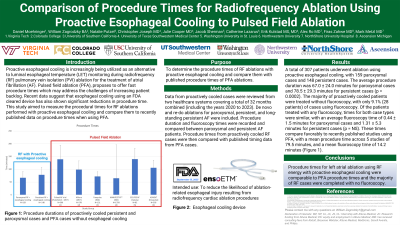Other
Comparison of Procedure Times for Radiofrequency Ablation Using Proactive Esophageal Cooling to Pulsed Field Ablation

William Zagrodzky, BA – Research Consultant, Attune Medical; Natalie Putzel, n/a – Student, University of Southern California; Christopher Joseph, MD – Physician, University of Texas Southwestern Medical Center; Julie Cooper, MD – Physician, University of Texas Southwestern Medical Center; Jacob Sherman, n/a – Student, Washington University in St. Louis; Catherine Lazarus, n/a – Student, Northwestern University; Erik Kulstad, MD – Physician, University of Texas Southwestern Medical Center; Alex Ro, MD – Electrophysiologist, NorthShore University Hospital; Firas Zahwe, MD – Electrophysiologist, Ascension Macomb-Oakland Hospital; Mark Metzl, MD – Electrophysiologist, NorthShore University Hospital
Purpose: Proactive esophageal cooling is increasingly being utilized as an alternative to luminal esophageal temperature (LET) monitoring during radiofrequency (RF) pulmonary vein isolation (PVI) ablation for the treatment of atrial fibrillation (AF). Pulsed field ablation (PFA), proposes to offer fast procedure times which may address the challenges of increasing patient backlog. However, recent data suggest that esophageal cooling is associated with significant reductions in procedure time. This study aimed to measure the procedural times for RF ablations performed with proactive esophageal cooling and compare them to recently published data on procedure times when using PFA.
Material and Methods: Data were reviewed from two healthcare systems covering a total of 32 months combined (including the years 2020 to 2023). De novo and re-do ablations for paroxysmal, persistent, and long-standing persistent AF were included. Procedure duration and fluoroscopy times were recorded and compared between paroxysmal and persistent AF patients.
Results: A total of 307 patients underwent ablation using proactive esophageal cooling, with 159 paroxysmal cases and 148 persistent cases. The average procedure duration was 67.0 ± 24.0 minutes for paroxysmal cases and 78.5 ± 29.3 minutes for persistent cases (p = 0.0002). The majority of proactively cooled patients were treated without fluoroscopy, with only 9.1% (28 patients) of cases using fluoroscopy. Of the patients treated with any fluoroscopy, times for both case types were similar, with an average fluoroscopy time of 0.44 ± 1.5 minutes for paroxysmal cases and 1.31 ± 5.3 minutes for persistent cases (p = NS). These times compare favorably to recently published studies using PFA, with a mean procedure time across 5 studies of 79.5 minutes, and a mean fluoroscopy time of 14.2 minutes.
Conclusions: Procedure times for left atrial ablation using RF energy with proactive esophageal cooling were short and the majority were completed with no fluoroscopy.
Material and Methods: Data were reviewed from two healthcare systems covering a total of 32 months combined (including the years 2020 to 2023). De novo and re-do ablations for paroxysmal, persistent, and long-standing persistent AF were included. Procedure duration and fluoroscopy times were recorded and compared between paroxysmal and persistent AF patients.
Results: A total of 307 patients underwent ablation using proactive esophageal cooling, with 159 paroxysmal cases and 148 persistent cases. The average procedure duration was 67.0 ± 24.0 minutes for paroxysmal cases and 78.5 ± 29.3 minutes for persistent cases (p = 0.0002). The majority of proactively cooled patients were treated without fluoroscopy, with only 9.1% (28 patients) of cases using fluoroscopy. Of the patients treated with any fluoroscopy, times for both case types were similar, with an average fluoroscopy time of 0.44 ± 1.5 minutes for paroxysmal cases and 1.31 ± 5.3 minutes for persistent cases (p = NS). These times compare favorably to recently published studies using PFA, with a mean procedure time across 5 studies of 79.5 minutes, and a mean fluoroscopy time of 14.2 minutes.
Conclusions: Procedure times for left atrial ablation using RF energy with proactive esophageal cooling were short and the majority were completed with no fluoroscopy.
